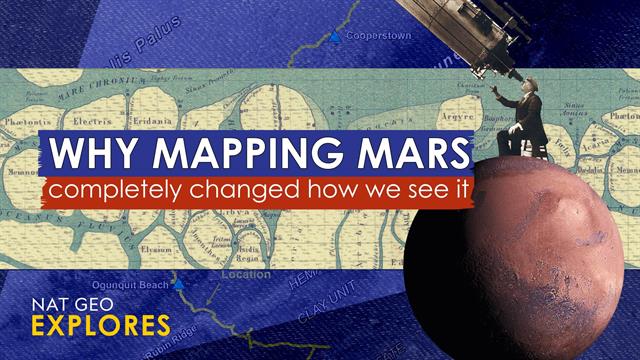Mapping Mars: A History Of Competition And Discovery

Welcome to your ultimate source for breaking news, trending updates, and in-depth stories from around the world. Whether it's politics, technology, entertainment, sports, or lifestyle, we bring you real-time updates that keep you informed and ahead of the curve.
Our team works tirelessly to ensure you never miss a moment. From the latest developments in global events to the most talked-about topics on social media, our news platform is designed to deliver accurate and timely information, all in one place.
Stay in the know and join thousands of readers who trust us for reliable, up-to-date content. Explore our expertly curated articles and dive deeper into the stories that matter to you. Visit NewsOneSMADCSTDO now and be part of the conversation. Don't miss out on the headlines that shape our world!
Table of Contents
Mapping Mars: A History of Competition and Discovery
For centuries, Mars, the red planet, has captivated humanity's imagination. From ancient astronomers charting its movements to modern-day rovers meticulously mapping its surface, the quest to understand Mars has been a relentless pursuit fueled by both international competition and an insatiable thirst for discovery. This journey, fraught with challenges and breakthroughs, has yielded an unprecedented understanding of our celestial neighbor and offers invaluable clues to the potential for past or present life beyond Earth.
Early Observations and the Birth of Cartography:
Early mapping of Mars relied heavily on telescopic observations. Astronomers like Giovanni Schiaparelli, in the late 19th century, made significant contributions, albeit sometimes controversial. His observations, leading to the (erroneous) identification of "canali" (channels), sparked fervent speculation about Martian civilization and fueled a wave of public interest in the planet. These early maps, though rudimentary by today's standards, laid the groundwork for future explorations. The limitations of ground-based telescopes, however, meant the detail was necessarily limited, leading to much speculation and debate.
The Space Race and the First Close-Ups:
The space race between the United States and the Soviet Union in the mid-20th century dramatically accelerated Mars exploration. Mariner 4, launched by NASA in 1964, provided the first close-up images of Mars, revealing a cratered, seemingly desolate landscape. This marked a shift from imaginative speculation to a more data-driven approach to understanding the planet's geology. Subsequent Mariner missions, along with the Soviet probes, gradually improved our understanding of Mars' atmosphere and surface features, contributing to more accurate and detailed maps.
Orbital Mapping and the Rise of Global Perspectives:
The advent of orbiting spacecraft revolutionized Martian cartography. Missions like Mars Global Surveyor (MGS) and Mars Reconnaissance Orbiter (MRO) provided high-resolution images, allowing scientists to create detailed global maps showcasing a wealth of features – from massive canyons like Valles Marineris to the polar ice caps. These missions utilized advanced imaging techniques, including stereo imaging and laser altimetry, to generate three-dimensional maps with unprecedented accuracy. This data has been instrumental in identifying potential landing sites for future missions and understanding the planet's geological history.
Rovers and the Ground Truth:
While orbiting spacecraft provide a global perspective, rovers offer a close-up, ground-level view. The Sojourner, Spirit, Opportunity, Curiosity, and Perseverance rovers have not only traveled across the Martian surface, but have also collected invaluable data about the planet's composition, climate, and potential for past habitability. These rovers' findings have significantly refined existing maps and provided crucial context for interpreting orbital imagery. Their detailed, localized maps contribute immensely to a more complete understanding of Mars' diverse geological features.
The Future of Martian Mapping:
The future of mapping Mars involves even more ambitious goals. Future missions aim to explore deeper subsurface features, analyze the planet's interior, and even search for biosignatures—evidence of past or present life. Advanced technologies, including improved sensors and sophisticated AI-driven analysis, will be essential for achieving these objectives. Furthermore, international collaboration is increasingly crucial for sharing data and resources, ensuring a more comprehensive and collaborative approach to exploring the red planet. The ongoing competition remains, but it increasingly takes the form of a race to understanding, rather than a race for mere conquest.
Conclusion:
The history of mapping Mars is a testament to human ingenuity and perseverance. From early telescopic observations to sophisticated robotic explorers, our understanding of the red planet has dramatically evolved. While the quest for knowledge continues, the detailed maps generated over decades of exploration are crucial, not only for scientific understanding but also for planning future human missions to Mars, a goal that seems increasingly attainable. The legacy of competition and collaboration will undoubtedly shape the next chapter in this ongoing saga of discovery.

Thank you for visiting our website, your trusted source for the latest updates and in-depth coverage on Mapping Mars: A History Of Competition And Discovery. We're committed to keeping you informed with timely and accurate information to meet your curiosity and needs.
If you have any questions, suggestions, or feedback, we'd love to hear from you. Your insights are valuable to us and help us improve to serve you better. Feel free to reach out through our contact page.
Don't forget to bookmark our website and check back regularly for the latest headlines and trending topics. See you next time, and thank you for being part of our growing community!
Featured Posts
-
 Werder Frauen Gegen Frankfurt Klarer Sieg Fuer Die Gaeste
Mar 30, 2025
Werder Frauen Gegen Frankfurt Klarer Sieg Fuer Die Gaeste
Mar 30, 2025 -
 Evaluating Yann Le Cuns Ai Outlook The Progress Of Robotaxis And Humanoid Robots By 2026
Mar 30, 2025
Evaluating Yann Le Cuns Ai Outlook The Progress Of Robotaxis And Humanoid Robots By 2026
Mar 30, 2025 -
 Jogo Ao Vivo Acompanhe Estoril X Porto Pela Liga Portugal
Mar 30, 2025
Jogo Ao Vivo Acompanhe Estoril X Porto Pela Liga Portugal
Mar 30, 2025 -
 Marquez Triumphs Austin Sprint Race Victory
Mar 30, 2025
Marquez Triumphs Austin Sprint Race Victory
Mar 30, 2025 -
 Analyzing The Yankees Bullpen Who Makes The Opening Day Cut
Mar 30, 2025
Analyzing The Yankees Bullpen Who Makes The Opening Day Cut
Mar 30, 2025
